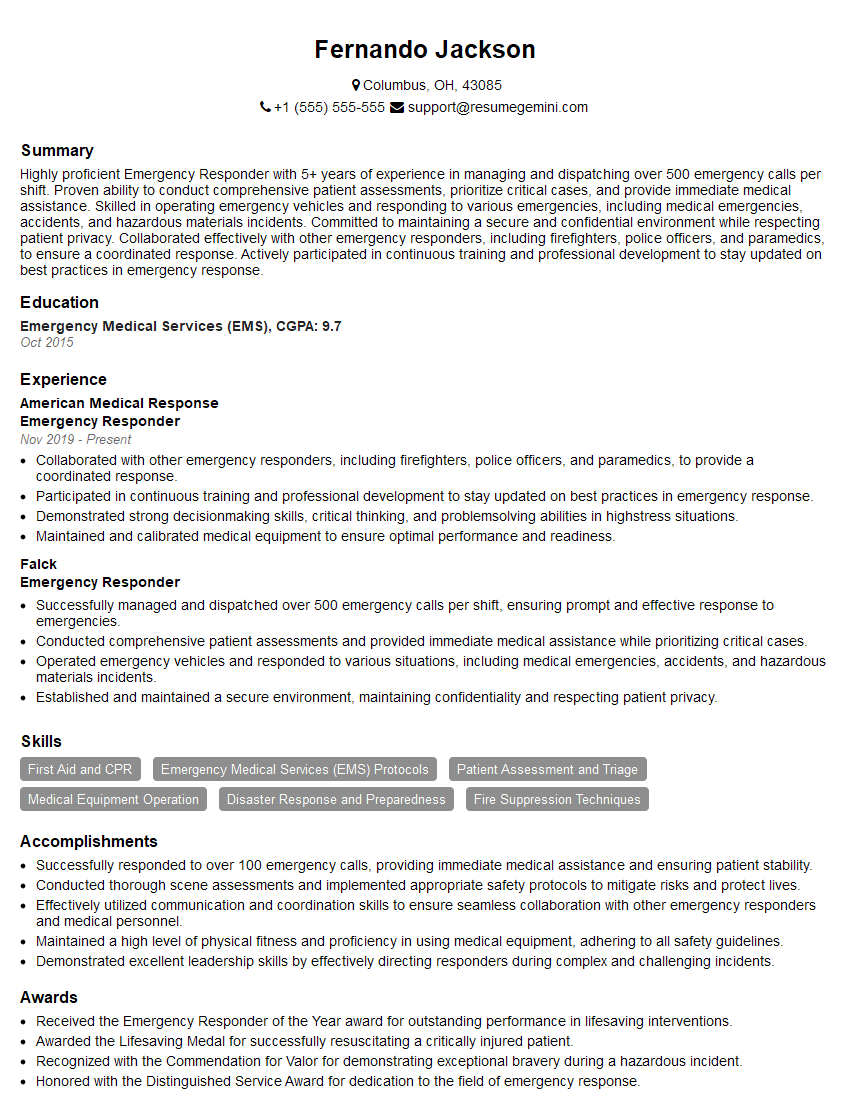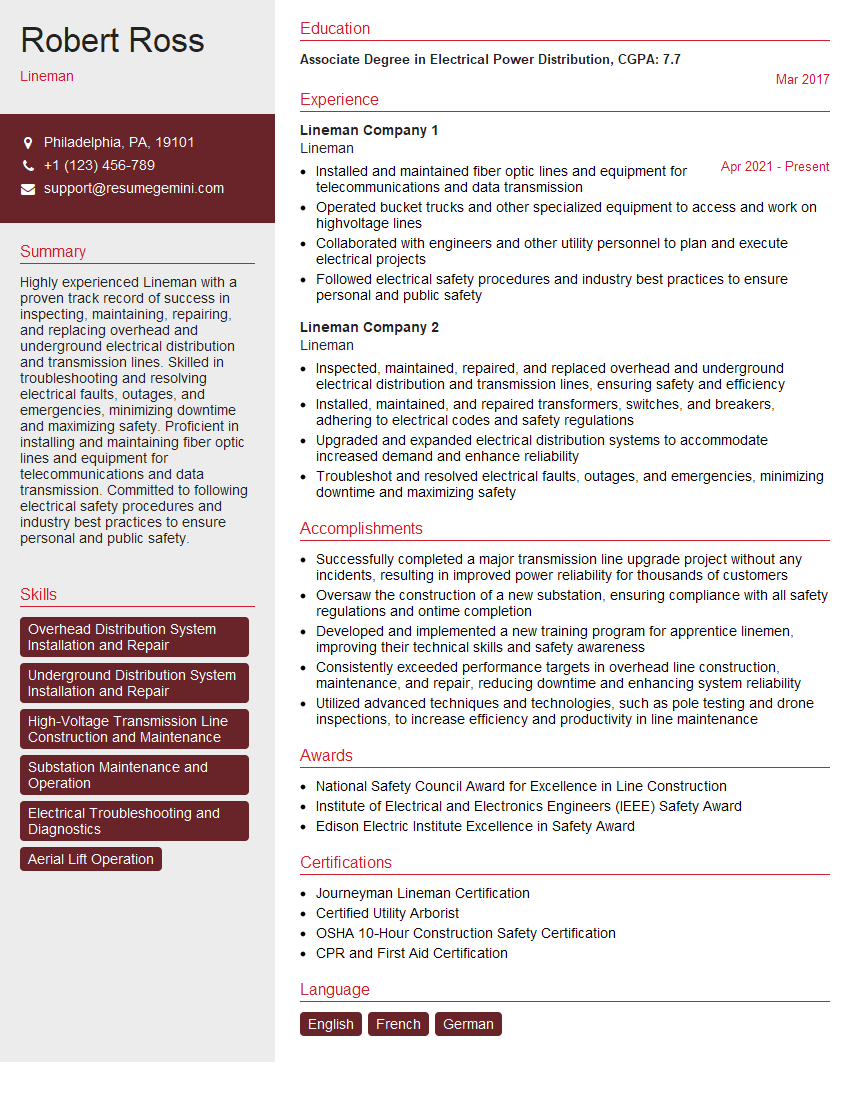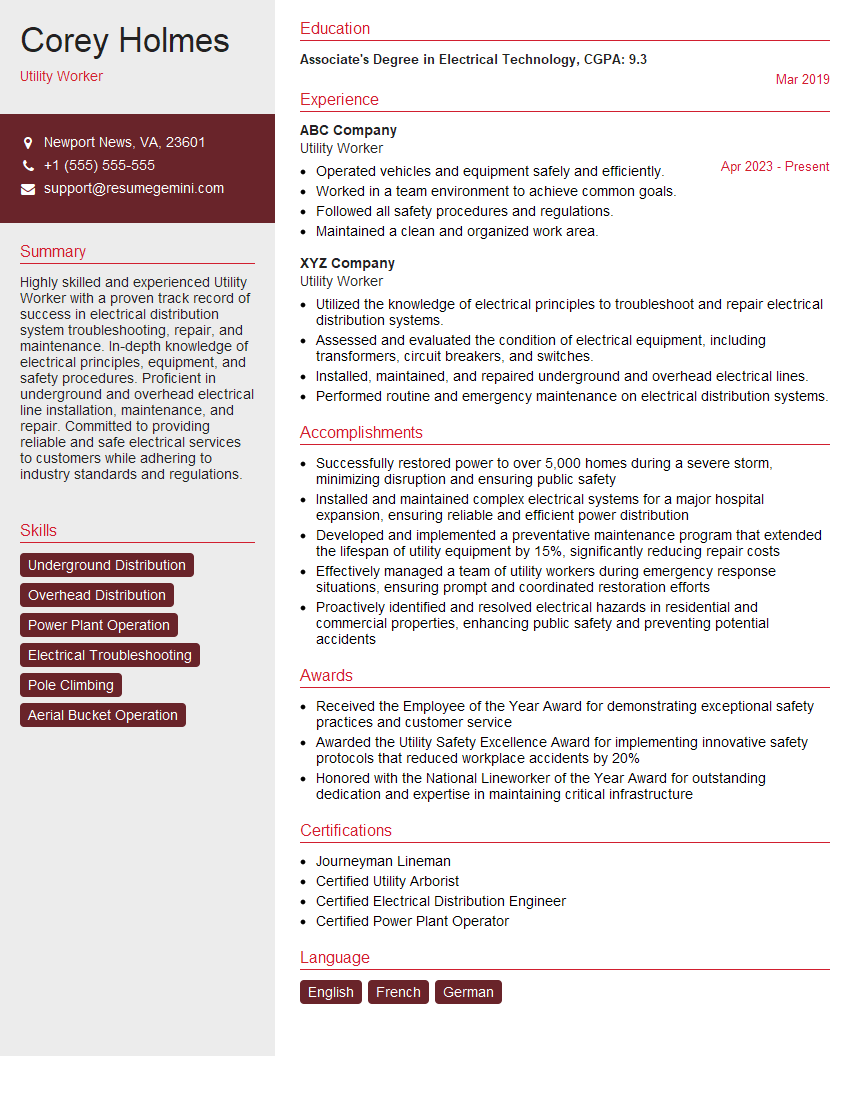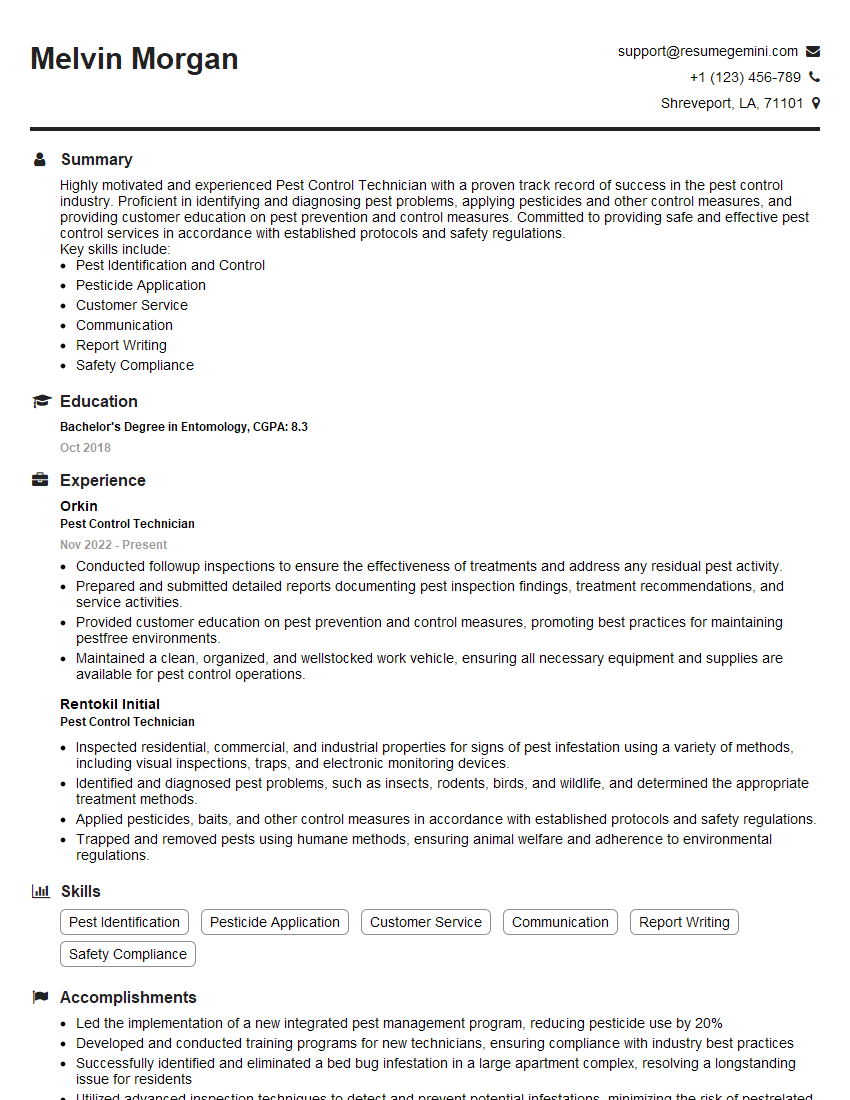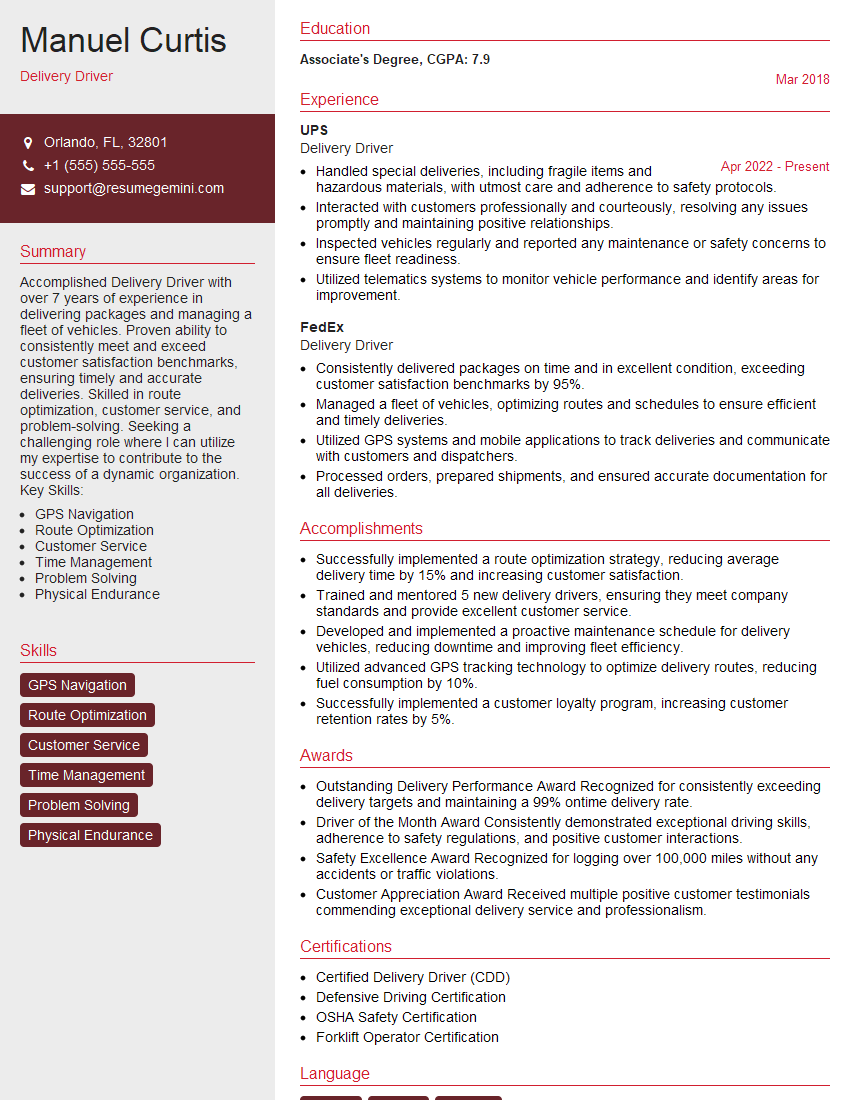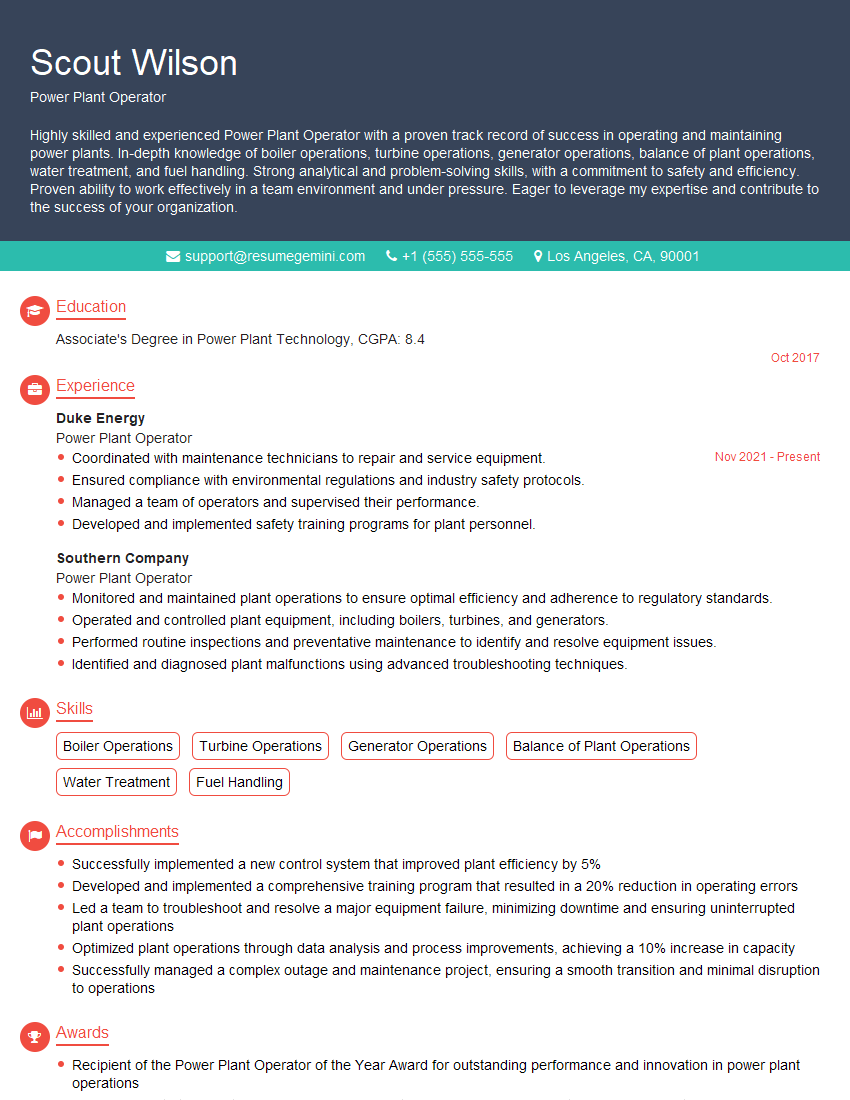Preparation is the key to success in any interview. In this post, we’ll explore crucial Working in Hot and Humid Environments interview questions and equip you with strategies to craft impactful answers. Whether you’re a beginner or a pro, these tips will elevate your preparation.
Questions Asked in Working in Hot and Humid Environments Interview
Q 1. Describe your experience working in hot and humid conditions.
My experience working in hot and humid conditions spans over 15 years, encompassing various roles in construction, industrial maintenance, and agricultural settings. I’ve worked in environments ranging from tropical rainforests to desert regions during peak summer months. This experience has instilled in me a deep understanding of the challenges posed by heat stress and the importance of proactive safety measures. For example, while working on a pipeline project in the Amazon basin, we faced ambient temperatures consistently above 95°F (35°C) with high humidity. Successfully completing that project required meticulous attention to heat safety protocols, which I’ll elaborate on further.
Q 2. What safety measures do you follow to prevent heatstroke?
Preventing heatstroke is paramount. My safety measures are multi-faceted and begin with acclimatization – gradually increasing exposure to the heat. Beyond that, I meticulously follow these steps:
- Hydration: I consistently drink plenty of water throughout the day, even before feeling thirsty. Electrolyte drinks are crucial for replacing lost salts.
- Protective Clothing: I wear light-colored, loose-fitting, and breathable clothing to reflect sunlight and allow for proper air circulation. I also utilize specialized cooling vests when appropriate.
- Rest Breaks: Frequent rest breaks in shaded or air-conditioned areas are essential. These breaks allow the body to cool down and recover.
- Buddy System: Working with a partner ensures constant monitoring of each other for signs of heat illness.
- Environmental Monitoring: I’m trained to use wet-bulb globe temperature (WBGT) instruments to assess the risk level and adjust work schedules accordingly.
- Heat Safety Training: Regular refresher training reinforces safe work practices and ensures everyone on the team is aware of the risks and mitigation strategies.
This systematic approach minimizes the risk of heatstroke, a potentially fatal condition.
Q 3. How do you recognize the signs and symptoms of heat exhaustion?
Recognizing the signs of heat exhaustion is crucial for timely intervention. Early symptoms are often subtle and can easily be overlooked. Key indicators include:
- Heavy sweating: Profuse perspiration is often one of the first signs.
- Weakness or fatigue: Feeling unusually tired or lacking energy.
- Headache: A dull throbbing headache is common.
- Dizziness: Feeling lightheaded or faint.
- Muscle cramps: Painful spasms in the legs or arms.
- Nausea or vomiting: Feeling sick to the stomach.
- Rapid heartbeat: An elevated pulse rate.
If any of these symptoms are present, immediate action is required. Moving to a cool place, hydrating, and seeking medical attention if symptoms worsen are critical steps.
Q 4. Explain your understanding of heat stress and its effects on the body.
Heat stress is the body’s response to excessive environmental heat, causing physiological strain. The body typically cools itself through sweating, but in high heat and humidity, this mechanism becomes less efficient. This leads to a buildup of heat, which can damage cells and organs. Effects vary in severity but can include:
- Dehydration: Loss of fluids, leading to decreased blood volume and impaired circulation.
- Electrolyte imbalance: Loss of essential minerals like sodium and potassium, disrupting muscle function.
- Cardiovascular strain: Increased heart rate and blood pressure, putting added stress on the heart.
- Heat exhaustion: A serious condition characterized by fatigue, weakness, dizziness, and nausea.
- Heatstroke: A life-threatening emergency involving a dramatic rise in body temperature, leading to organ damage and possible death.
The severity of heat stress depends on factors like ambient temperature, humidity, workload, and individual fitness levels. Understanding these factors helps to mitigate risk effectively.
Q 5. What are the different types of heat-related illnesses?
Heat-related illnesses form a spectrum of severity:
- Heat rash: A skin irritation caused by blocked sweat glands.
- Heat cramps: Painful muscle spasms due to electrolyte imbalance and dehydration.
- Heat exhaustion: A serious but not life-threatening condition characterized by symptoms like weakness, dizziness, and nausea.
- Heatstroke: A life-threatening emergency involving a dangerously high body temperature, leading to organ damage and potential death.
Early recognition of symptoms is crucial for appropriate treatment, ranging from rest and hydration for heat rash and cramps, to immediate medical attention for heat exhaustion and heatstroke.
Q 6. Describe your experience with personal protective equipment (PPE) in hot environments.
My experience with PPE in hot environments highlights the crucial balance between protection and comfort. While PPE is essential for safety in many industrial settings, it can significantly increase the risk of heat stress. I’ve worked with various PPE, including:
- High-visibility clothing: Choosing light-colored, breathable fabrics is crucial. Reflective materials are important, but they can also increase heat retention, so careful selection is essential.
- Protective helmets: Ventilation is key. Helmets with good airflow can significantly reduce heat stress.
- Gloves: Choosing appropriately rated and breathable gloves is crucial. Regular breaks and changes of gloves can help.
- Safety footwear: Breathable safety footwear helps prevent foot injuries and heat stress.
In hot conditions, we often employ strategies like scheduled PPE breaks, utilizing cooling vests under protective clothing, and careful hydration planning to manage the risks associated with prolonged PPE use.
Q 7. How do you manage hydration while working in hot and humid conditions?
Hydration is the cornerstone of heat safety. It’s not just about drinking enough water; it’s about a strategic approach:
- Proactive Hydration: I start drinking water well before work begins, even if I don’t feel thirsty. This prevents dehydration from developing in the first place.
- Frequent Sips: I drink water frequently throughout the day, rather than just large amounts infrequently. This helps maintain consistent hydration.
- Electrolytes: I utilize electrolyte drinks to replace essential minerals lost through sweat. Plain water is not sufficient to replace all lost electrolytes.
- Avoid Dehydrating Beverages: I avoid sugary drinks, caffeinated beverages, and alcohol, all of which can exacerbate dehydration.
- Monitor Urine Color: A pale yellow urine color indicates good hydration; dark yellow suggests dehydration.
My hydration strategy is tailored to the specific environmental conditions, workload, and personal sweat rate. Consistent monitoring and adaptation are key to staying well-hydrated in challenging heat and humidity.
Q 8. What strategies do you use to stay cool and comfortable in hot weather?
Staying cool and comfortable in hot weather requires a multi-pronged approach focusing on hydration, appropriate clothing, and smart work practices. It’s not just about feeling better; it’s about preventing heat stress and illness.
- Hydration: I drink plenty of water throughout the day, even before I feel thirsty. Electrolyte drinks can be beneficial for replenishing lost salts through sweat. I avoid sugary drinks, which can dehydrate you further.
- Clothing: I wear light-colored, loose-fitting clothing made of breathable fabrics like cotton or linen. This allows air to circulate and helps wick away sweat. A wide-brimmed hat is crucial for sun protection.
- Work Scheduling: If possible, I adjust my work schedule to avoid the hottest parts of the day. Taking more frequent breaks in shaded areas is essential.
- Cooling Methods: I utilize cooling methods like fans, cooling vests, or wet towels applied to pulse points.
- Acclimatization: Gradual acclimatization to hot weather is crucial. My body needs time to adjust to the increased heat load. Starting with shorter work periods in the heat and gradually increasing duration is key.
Q 9. How do you adjust your work pace and workload in extreme heat?
Adjusting work pace and workload in extreme heat is paramount to safety and productivity. Pushing yourself too hard leads to heat exhaustion and reduces efficiency. My approach involves:
- Reduced Workload: I break down large tasks into smaller, more manageable chunks. This prevents fatigue and allows for more frequent rest periods.
- Slower Pace: I deliberately slow my work pace, focusing on quality over speed. Rushing increases the risk of accidents and heat-related illnesses.
- Frequent Breaks: I take frequent breaks in shaded or air-conditioned areas to allow my body to cool down. Even a short 5-10 minute break can make a significant difference.
- Hydration Breaks: Breaks are also dedicated to rehydration. This helps maintain electrolyte balance and prevents dehydration.
- Prioritization: I prioritize critical tasks and delegate less urgent work if possible to conserve energy.
For instance, during a particularly hot day while working on a construction site, instead of trying to complete the entire wall in one go, I’d focus on completing a section, take a break, and then move on to another section.
Q 10. What are the challenges of working with machinery in hot and humid conditions?
Working with machinery in hot and humid conditions presents unique challenges that necessitate extra precautions. The heat affects both the machinery and the operator.
- Overheating of Machinery: Extreme heat can cause machinery to overheat, leading to malfunctions or breakdowns. Regular maintenance checks and potentially modified operating procedures are necessary. For example, equipment may require more frequent oil changes or adjustments to prevent seizing.
- Reduced Efficiency: Heat reduces the efficiency of many machines, making them slower and less productive.
- Increased Risk of Accidents: Heat stress impairs judgment and reaction time, increasing the risk of accidents involving machinery.
- Material Degradation: Heat and humidity can affect the performance and longevity of some machinery parts, causing degradation over time.
- Operator Safety: Operators are at greater risk of heat stroke and other heat-related illnesses. Additional safety measures and frequent breaks are essential.
Q 11. How do you maintain productivity while working in extreme heat?
Maintaining productivity in extreme heat requires a careful balance of work and rest. It’s not about pushing harder, but working smarter.
- Proper Planning: Careful planning of work tasks, considering the heat and humidity, is vital. This involves breaking down large jobs into smaller, more manageable parts.
- Hydration and Breaks: Frequent hydration and breaks are essential to prevent heat exhaustion. I’ve found that short, frequent breaks are more effective than one long break.
- Teamwork and Support: Working as a team allows for mutual support and monitoring of each other’s well-being. This fosters a culture of safety and reduces the risk of heat-related illnesses.
- Acclimatization: Gradually increasing exposure to heat helps the body adapt, thereby improving tolerance and work capacity.
- Utilizing Technology: Technology like cooling vests, fans, and shaded work areas can significantly improve work comfort and productivity.
Q 12. Describe your experience working with heat-sensitive materials.
My experience working with heat-sensitive materials has taught me the importance of meticulous planning and careful execution. These materials can be easily damaged or compromised by temperature fluctuations and humidity.
- Temperature Control: Maintaining a stable temperature and humidity level is crucial. This often involves using climate-controlled environments or specialized storage facilities.
- Protective Measures: Protective measures like insulation and specialized handling equipment are often necessary.
- Careful Handling: Gentle handling is crucial to prevent damage. This includes minimizing contact with hot surfaces and avoiding abrupt temperature changes.
- Material Selection: Choosing appropriate materials that can withstand the ambient conditions is crucial to prevent performance issues.
- Monitoring: Continuous monitoring of the material’s temperature and condition is essential to prevent damage and maintain quality. For example, I worked on a project involving high-precision optics. These components needed to be handled in a climate-controlled clean room to avoid thermal shock or moisture damage.
Q 13. How do you communicate safety concerns regarding heat stress to your colleagues?
Communicating safety concerns regarding heat stress is crucial for maintaining a safe working environment. My approach includes:
- Direct Communication: I directly address my colleagues if I observe signs of heat stress, such as dizziness, nausea, or excessive sweating.
- Team Meetings: I participate actively in team meetings to address heat-related safety concerns and provide recommendations.
- Reporting Procedures: I am diligent in reporting any heat-related incidents or near misses through established reporting channels.
- Education and Training: I participate in and actively promote heat stress awareness training for colleagues.
- Lead by Example: I demonstrate proper hydration practices and take regular breaks to reinforce the importance of heat safety.
For example, if I noticed a colleague exhibiting signs of heat exhaustion, I’d immediately encourage them to take a break in a cool area, drink plenty of fluids, and seek medical attention if necessary. I’d also report the incident to the supervisor.
Q 14. What are the legal and regulatory requirements for working in hot and humid environments?
Legal and regulatory requirements for working in hot and humid environments vary by location but generally focus on preventing heat-related illnesses and ensuring worker safety. These requirements usually include:
- Workplace Monitoring: Regular monitoring of workplace temperature and humidity levels is often mandated.
- Rest Breaks: Regulations often specify the frequency and duration of rest breaks, particularly in extreme heat.
- Hydration: Employers are frequently required to provide access to potable water.
- Training: Workers often require training on heat stress prevention and recognition of symptoms.
- Personal Protective Equipment (PPE): The provision of appropriate PPE, such as protective clothing and hats, may be required.
- Emergency Procedures: Employers must have clear procedures for responding to heat-related emergencies.
It’s essential to be familiar with the specific regulations in your jurisdiction. Failure to comply can lead to significant penalties.
Q 15. Describe your understanding of acclimatization to hot and humid climates.
Acclimatization to hot and humid climates is the body’s physiological adaptation to prolonged exposure to heat. It’s not just getting used to it; it’s a complex process involving several changes to improve your body’s ability to regulate temperature. Think of it like training for a marathon – your body gets better at it over time.
- Reduced Heart Rate: Your heart doesn’t have to work as hard to pump blood to the skin for cooling.
- Increased Plasma Volume: Your blood volume increases, improving blood flow and heat dissipation.
- Sweating Efficiency: You sweat earlier and more profusely, making the cooling process more effective. Your sweat also becomes less salty.
- Lower Core Body Temperature: Your body’s natural thermostat adjusts to a slightly lower set point.
This process typically takes 7-14 days of consistent exposure to heat, but the rate of acclimatization depends on factors like age, fitness level, and the intensity of the heat exposure. Someone already fit and regularly exercising in moderate heat will acclimatize faster than someone sedentary entering a drastically hotter climate.
Career Expert Tips:
- Ace those interviews! Prepare effectively by reviewing the Top 50 Most Common Interview Questions on ResumeGemini.
- Navigate your job search with confidence! Explore a wide range of Career Tips on ResumeGemini. Learn about common challenges and recommendations to overcome them.
- Craft the perfect resume! Master the Art of Resume Writing with ResumeGemini’s guide. Showcase your unique qualifications and achievements effectively.
- Don’t miss out on holiday savings! Build your dream resume with ResumeGemini’s ATS optimized templates.
Q 16. How do you adapt your work schedule to mitigate heat risks?
Adapting work schedules to mitigate heat risks is crucial. It’s not just about working fewer hours; it’s about strategically planning work around the hottest parts of the day.
- Shift Work: Consider shifting work to cooler parts of the day or night, minimizing exposure to peak temperatures.
- Reduced Workload: During the hottest periods, tasks should be reduced in intensity or number to prevent overexertion.
- Frequent Breaks: Implementing more frequent, shorter breaks allows workers to rest and cool down, rather than fewer, longer breaks in the heat.
- Hydration Breaks: Designated, scheduled hydration breaks are critical. These shouldn’t be combined with other breaks but given the importance they deserve.
- Rotating Tasks: Workers should rotate tasks to ensure they aren’t exposed to the most intense conditions continuously.
For example, in a construction site, the heaviest work could be scheduled for the early morning or late afternoon, with lighter tasks during the hottest hours. This proactive approach significantly reduces heat-related illness risks.
Q 17. What are the signs of heatstroke and what is the proper emergency response?
Heatstroke is a life-threatening condition, a severe form of heat illness. Recognizing the signs is paramount for a rapid response.
- High Body Temperature: Temperature above 103°F (39.4°C).
- Altered Mental State: Confusion, disorientation, seizures, loss of consciousness.
- Hot, Dry Skin: Unlike heat exhaustion, the skin might be flushed but not necessarily sweaty.
- Rapid Pulse: A fast and strong heartbeat.
- Headache, Dizziness, Nausea: These are common early warning signs.
Emergency Response:
- Call emergency services immediately.
- Move the person to a cool place.
- Remove excess clothing.
- Cool the person down using methods like ice packs, cold water baths, or fans.
- Monitor breathing and pulse.
- Do NOT give the person anything to drink.
Time is critical with heatstroke. Rapid intervention can be life-saving. Remember, prevention is far better than cure.
Q 18. How do you ensure proper ventilation and cooling in confined spaces during hot weather?
Ensuring proper ventilation and cooling in confined spaces during hot weather requires a multi-faceted approach.
- Mechanical Ventilation: Utilize fans, exhaust systems, or air conditioning units to circulate air and remove hot, stale air. The size and capacity of these systems should be appropriate for the size and heat load of the space.
- Natural Ventilation: Open windows and doors whenever safe and practical. Cross-ventilation is particularly effective.
- Portable Coolers: Evaporative coolers or air conditioning units can provide localized cooling in smaller confined spaces.
- Monitoring: Use temperature and humidity sensors to constantly monitor conditions and ensure they remain within safe limits.
- Personal Protective Equipment (PPE): Providing workers with appropriate PPE, such as cooling vests or helmets, can help minimize heat stress.
For example, in a mine shaft, a carefully planned ventilation system with multiple fans and monitoring equipment would be crucial. Failing to do so can lead to a dangerous buildup of heat and humidity, resulting in serious health risks for workers.
Q 19. Explain the importance of regular breaks and rest periods in hot environments.
Regular breaks and rest periods are not optional in hot environments; they’re essential for worker safety and productivity. Prolonged exposure to heat leads to fatigue, dehydration, and increased risk of heat-related illness.
- Reduced Fatigue: Breaks help combat heat-induced fatigue, allowing workers to maintain focus and performance.
- Improved Hydration: Breaks provide opportunities to replenish fluids lost through sweat.
- Lowered Core Temperature: Rest in a cool area allows the body to recover from heat stress and lower its core temperature.
- Increased Productivity: Counterintuitively, frequent short breaks often lead to higher overall productivity.
Imagine a construction worker continuously working in direct sunlight. Without regular breaks, they risk exhaustion, heatstroke, and potentially accidents. Structured breaks, ideally in shaded or air-conditioned areas, allow the worker to recover and perform better over the long haul.
Q 20. What are some preventative measures to reduce the risk of heat-related illness?
Preventing heat-related illness requires a proactive and multifaceted approach that focuses on personal protection, workplace modifications, and education.
- Hydration: Encourage frequent water consumption throughout the workday, avoiding sugary drinks.
- Appropriate Clothing: Wear light-colored, loose-fitting, and breathable clothing. Consider protective clothing with moisture-wicking properties.
- Sun Protection: Utilize hats, sunscreen, and sunglasses when working outdoors.
- Acclimatization: Gradually introduce workers to hot and humid environments, allowing their bodies to adapt.
- Workplace Modifications: Implement shaded areas, cooling systems, and regular monitoring of environmental conditions.
- Education and Training: Provide workers with comprehensive training on heat-related illnesses, prevention strategies, and emergency response procedures.
A combination of these measures establishes a comprehensive safety net, reducing the likelihood of heat-related emergencies.
Q 21. Describe a time you had to deal with a heat-related emergency at work.
During a particularly hot summer while working on an outdoor construction project, one of my colleagues started exhibiting signs of heat exhaustion. He was pale, sweating profusely, and complained of dizziness and nausea.
Immediately, we moved him to the shade, removed his hard hat, and loosened his clothing. We provided him with cool water to drink and encouraged him to rest. We also monitored his vital signs, watching for any deterioration. His condition improved relatively quickly and we were able to keep working at a lower intensity after that. Because his symptoms were mild, no further treatment was required. However, the incident highlighted the importance of our heat safety training and the necessity of vigilant monitoring of workers in hot environments. It reinforced the need for frequent breaks and re-evaluation of work schedules during extreme heat.
Q 22. How do you monitor the environmental conditions (temperature, humidity) at your worksite?
Monitoring environmental conditions in hot and humid work environments is crucial for worker safety. We utilize a multi-pronged approach. Firstly, we employ digital hygrometers and thermometers strategically placed throughout the worksite, ensuring readings are taken in various locations to account for microclimates. These devices are calibrated regularly for accuracy. Secondly, we might use a weather station if working in a larger area, providing real-time data on temperature, humidity, and even wind speed, which influences heat stress. Finally, we conduct regular spot checks using handheld devices, particularly in areas where equipment might generate additional heat. This combination allows for comprehensive monitoring and informs our decisions regarding work schedules, breaks, and the use of protective measures.
Q 23. What are the specific hazards of working outdoors in hot and humid conditions?
Working outdoors in hot and humid conditions presents several significant hazards. The primary risk is heat stress, encompassing heat exhaustion, heat stroke, and heat cramps. These conditions occur when the body struggles to regulate its internal temperature. High humidity exacerbates this because sweat, the body’s primary cooling mechanism, evaporates less efficiently in humid air. Other hazards include dehydration, leading to fatigue, dizziness, and impaired judgment; sunstroke, caused by prolonged sun exposure; and increased risk of accidents due to heat-related fatigue and reduced cognitive function. Skin conditions such as heat rash are also more prevalent. Finally, the interaction of heat with other workplace hazards (e.g., heavy lifting) dramatically increases the overall risk.
Q 24. How familiar are you with heat index charts and their interpretation?
I am very familiar with heat index charts. They are essential tools for assessing the combined effect of temperature and humidity on the human body. The heat index doesn’t simply add the temperature and humidity; it uses a complex formula to calculate the apparent temperature—how hot it actually feels to the human body. For instance, a temperature of 90°F (32°C) with 70% humidity might have a heat index of 105°F (41°C), indicating a significantly higher risk of heat stress. I understand how to interpret these charts to determine appropriate work restrictions, necessary hydration schedules, and the need for additional safety measures based on different heat index levels. This involves knowing the thresholds for different levels of heat stress and associated risks. For example, I know that when the heat index reaches dangerous levels, we need to implement work-rest cycles, increase hydration rates and potentially cease outdoor operations.
Q 25. How would you educate a new employee about working safely in hot and humid conditions?
Educating new employees on working safely in hot and humid conditions is paramount. My approach is multi-faceted. I start with a comprehensive safety briefing covering the hazards discussed earlier, emphasizing the dangers of heat stress and its various manifestations. I then explain how to recognize the symptoms of heat exhaustion and heat stroke. Practical demonstrations on how to use cooling vests, hydration strategies, and proper work-rest schedules are critical. I provide clear guidelines on recognizing and responding to heat-related emergencies. We use heat index charts as a visual aid to show the relationship between temperature, humidity, and risk. Real-world examples of heat-related incidents (without naming individuals, of course) are shared to highlight the seriousness of the risks. Finally, open communication is encouraged; employees are told to report any discomfort immediately, and supervisors are trained to be observant and proactive in identifying potential problems.
Q 26. What are the benefits of using cooling vests or other cooling devices?
Cooling vests and other cooling devices offer significant benefits in hot and humid environments. These devices help to lower core body temperature by evaporative cooling or conductive cooling, mitigating the effects of heat stress. Cooling vests, for example, utilize materials that wick away sweat and facilitate evaporation, while some incorporate small water reservoirs or cooling packs. The benefits include increased worker comfort and productivity, a reduction in heat-related illness, and prolonged safe working time in extreme conditions. For instance, a cooling vest could allow workers to safely continue operations for longer periods during a heatwave, preventing disruptions to project schedules and reducing the risk of heat-related injuries.
Q 27. Describe your experience with different types of hydration strategies.
My experience encompasses various hydration strategies, recognizing that a ‘one-size-fits-all’ approach doesn’t work. We encourage frequent consumption of water throughout the workday, emphasizing proactive hydration rather than waiting until thirsty. We also incorporate electrolyte drinks to replenish salts lost through sweat, especially during prolonged strenuous activity. The type and quantity of fluids offered vary depending on the heat index and the intensity of the work. We might provide plain water, electrolyte drinks, or even sports drinks with varying levels of sugar and electrolytes based on the demands of the task. Regular monitoring of workers’ hydration levels through observations and checking urine colour is also a key part of our strategy. We promote a culture where asking for water or taking frequent hydration breaks isn’t stigmatized. This approach considers individual needs and preferences, ensuring everyone stays adequately hydrated.
Q 28. What are the limitations of PPE in extreme heat and humidity?
While PPE is essential for many workplace hazards, its effectiveness is limited in extreme heat and humidity. Wearing protective clothing, such as those required for handling hazardous materials, significantly reduces the body’s ability to dissipate heat. This can lead to a rapid increase in core body temperature, increasing the risk of heatstroke. The added weight and insulation provided by PPE further hinder the body’s ability to cool itself. This limitation necessitates careful consideration of PPE selection and utilization in hot environments. It often requires prioritizing safety, selecting lighter-weight and more breathable materials where possible, and implementing shorter work cycles or more frequent breaks to minimize the risk of heat stress. In some extreme circumstances, it may even necessitate reassessing the task to see if alternative methods are feasible, such as using remote control systems. The limitations of PPE emphasize the crucial role of environmental monitoring and appropriate work practices to mitigate the additional risks posed by protective gear in intense heat.
Key Topics to Learn for Working in Hot and Humid Environments Interview
- Physiological Effects of Heat Stress: Understanding heat exhaustion, heat stroke, and other heat-related illnesses, including their symptoms and first aid responses.
- Acclimatization and Heat Tolerance: Exploring the body’s adaptation to hot and humid conditions and strategies for improving heat tolerance, such as gradual acclimatization and hydration techniques.
- Protective Clothing and Equipment: Analyzing the role of appropriate personal protective equipment (PPE) in mitigating heat stress, including the selection, use, and maintenance of heat-resistant clothing and safety gear.
- Hydration and Electrolyte Balance: Discussing the importance of fluid intake, electrolyte replenishment, and the impact of dehydration on performance and health in hot and humid environments.
- Work-Rest Cycles and Scheduling: Examining effective strategies for managing workload and incorporating rest breaks to minimize heat stress and enhance worker productivity and safety.
- Environmental Monitoring and Control: Understanding the use of instruments to measure environmental conditions (temperature, humidity, heat index) and implementing strategies for controlling the work environment to mitigate heat risks.
- Safety Procedures and Emergency Response: Developing proficiency in recognizing heat-related emergencies, implementing appropriate safety protocols, and conducting effective emergency response procedures.
- Regulations and Compliance: Familiarizing yourself with relevant occupational safety and health regulations and standards related to working in hot and humid environments.
- Practical Application: Be prepared to discuss real-world scenarios involving heat stress management, such as developing a heat stress prevention plan for a specific worksite or responding to a heat-related emergency.
Next Steps
Mastering the challenges of working in hot and humid environments demonstrates valuable skills in safety, risk management, and practical problem-solving – highly sought-after attributes that significantly boost your career prospects. To showcase these skills effectively, a well-crafted, ATS-friendly resume is crucial. ResumeGemini can help you create a compelling resume that highlights your relevant experience and qualifications, significantly increasing your chances of landing your dream job. We provide examples of resumes tailored to Working in Hot and Humid Environments to inspire and guide you. Take the next step toward a successful career today!
Explore more articles
Users Rating of Our Blogs
Share Your Experience
We value your feedback! Please rate our content and share your thoughts (optional).
What Readers Say About Our Blog
Hello,
We found issues with your domain’s email setup that may be sending your messages to spam or blocking them completely. InboxShield Mini shows you how to fix it in minutes — no tech skills required.
Scan your domain now for details: https://inboxshield-mini.com/
— Adam @ InboxShield Mini
Reply STOP to unsubscribe
Hi, are you owner of interviewgemini.com? What if I told you I could help you find extra time in your schedule, reconnect with leads you didn’t even realize you missed, and bring in more “I want to work with you” conversations, without increasing your ad spend or hiring a full-time employee?
All with a flexible, budget-friendly service that could easily pay for itself. Sounds good?
Would it be nice to jump on a quick 10-minute call so I can show you exactly how we make this work?
Best,
Hapei
Marketing Director
Hey, I know you’re the owner of interviewgemini.com. I’ll be quick.
Fundraising for your business is tough and time-consuming. We make it easier by guaranteeing two private investor meetings each month, for six months. No demos, no pitch events – just direct introductions to active investors matched to your startup.
If youR17;re raising, this could help you build real momentum. Want me to send more info?
Hi, I represent an SEO company that specialises in getting you AI citations and higher rankings on Google. I’d like to offer you a 100% free SEO audit for your website. Would you be interested?
Hi, I represent an SEO company that specialises in getting you AI citations and higher rankings on Google. I’d like to offer you a 100% free SEO audit for your website. Would you be interested?
good
